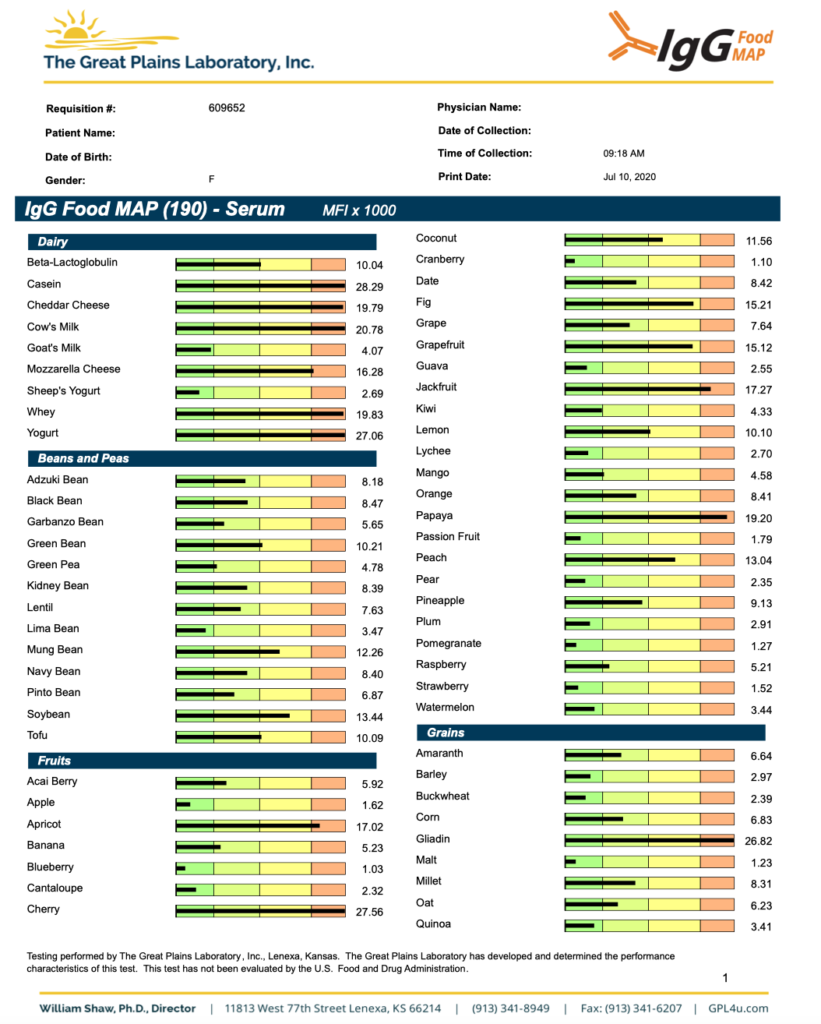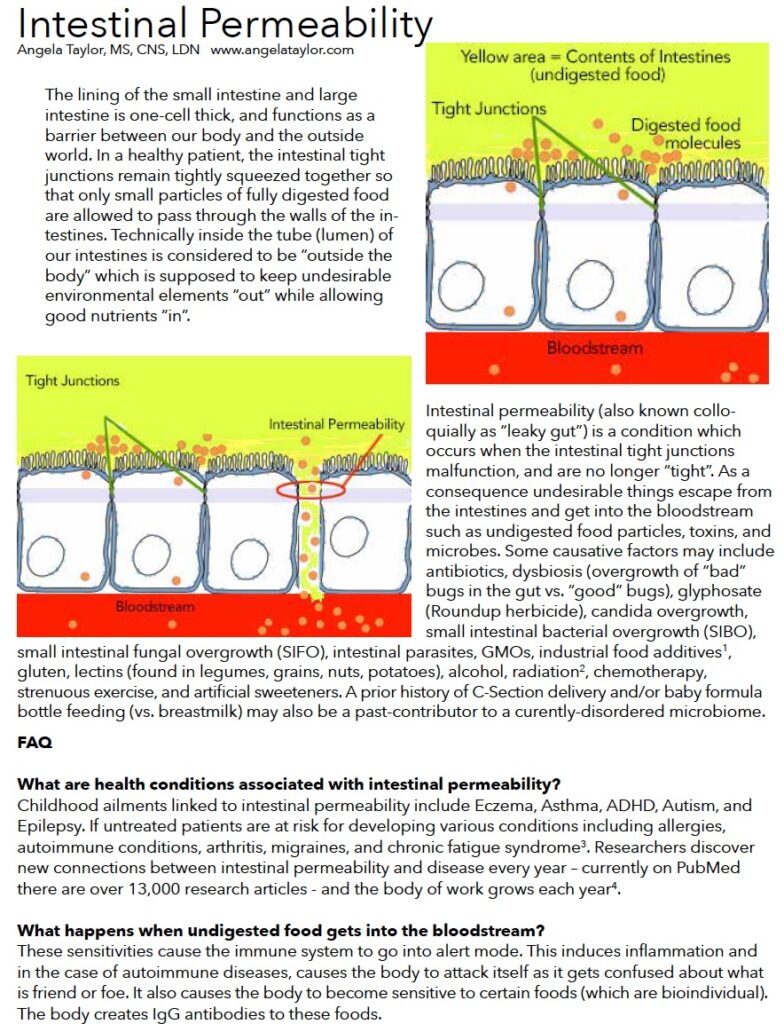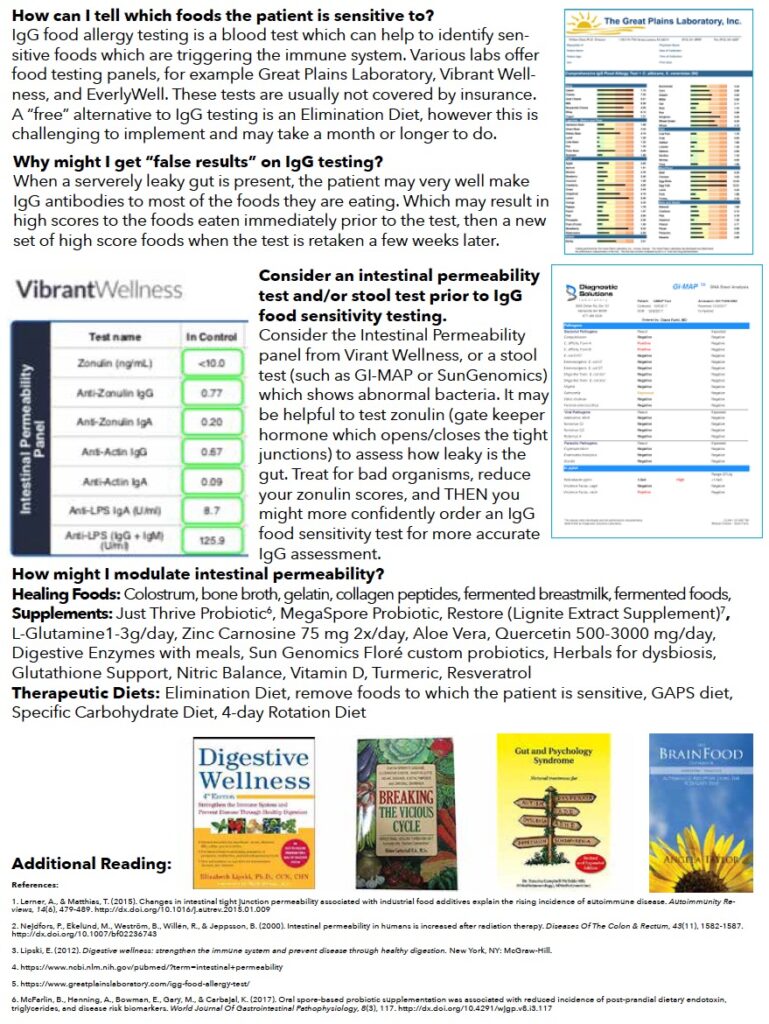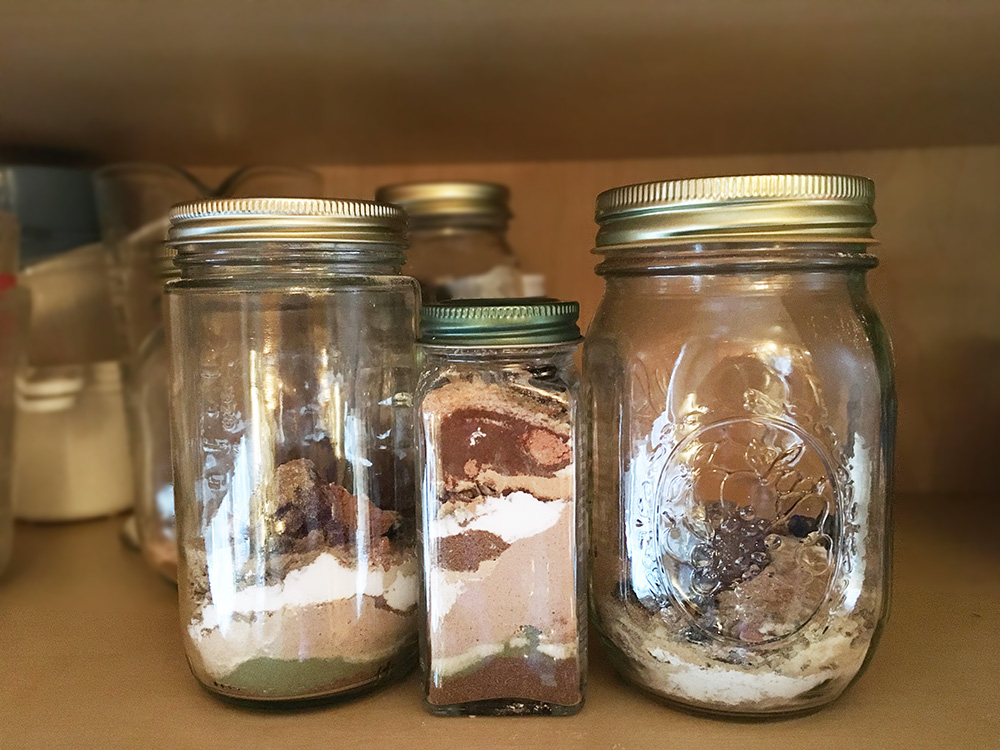IgG Food Sensitivity Testing
Q: I was just wondering if you think the IgG food testing kit from Everywell would work?
A: Perhaps – Everlywell looks like a perfectly good lab. And, it is handy for people to have access to an affordable direct-to-consumer test. However I do have some reservations about finger-prick IgG tests: someone taking immune suppressant meds, or with overall low SigA due to a worn-out immune system (surprisingly common) may get false negatives. (meaning, they actually do have food sensitivities but their test results will suggest things are OK) For this reason I always prefer to go with an actual serum draw (into vials) so Total Immunoglobulin levels can be measured (vs. at-home finger prick blood sample cards).
I’m a fan of this IgG test from Great Plains, which does offer serum testing https://www.greatplainslaboratory.com/food-map-igg-sensitivity-profile. However, a practitioner would need to order this test. (and BTW – there are several other good labs offering practitioner-ordered IgG tests)
My clinical experience of IgG food testing of people with healthy intestinal integrity suggests that people may very well have a few “forever-banned” foods unique to them. For example, my own lab testing shows that my gut is intact, yet I am highly reactive (make IgG antibodies) to lemons, bananas, pineapple, oysters, cabbage, and asparagus. Whereas my son (who also has healthy intestinal integrity) can safely eat all of my IgG problem foods, but he is highly reactive (makes IgG antibodies) to walnuts, pecans, and buckwheat.
I often recommend to my clients they work on alleviating intestinal permeability prior to IgG testing to maximize its accuracy. (see: Intestinal Permeability) Someone with a severely leaky gut may make IgG antibodies to virtually everything they are eating. (I wouldn’t call that false positives, because they actually are making antibodies when eating those foods right now.) But later on some of those foods may actually be OK for that person, if they fix their guts. So I often tell folks receiving their first-ever IgG foods test, these aren’t necessarily your forever-banned foods, but we ought to do some work to improve intestinal integrity/help your body reduce its production of antibodies to those foods before declaring them OK to eat again.
Common root causes for intestinal permeability include glyphosate, gut dysbiosis, and gluten consumption. Going gluten-free, eating organic, and filtering drinking water, are easy at-home steps anyone can take to improve their intestinal integrity. But reducing dysbiosis is a more challenging task – I have my best clinical success combining functional testing, specific herbals, and high doses of specific probiotics. Mold remediation is also called for if functional testing reveals a mold problem. My currently preferred functional lab tests are the Organic Acids and MycoTox from Great Plains combined with stool testing from Sun Genomics.
In conclusion, an IgG test from a direct-to-consumer lab using finger-prick collection cards may be useful for some people, but not everyone. Those with chronic health conditions may benefit from taking a look at the bigger picture including dysbiosis, mold, and intestinal permeability, along with food sensitivities.

Cronometer – Food Logging
Constipation
Many experts believe for best health your child should have a “Type 4” bowel movement at least once/day. (see Bristol Stool chart)
However according to WebMD, the definition of constipation is as follows:
The normal length of time between bowel movements varies widely from person to person. Some people have them three times a day. Others have them just a few times a week. Going longer than 3 or more days without one, though, is usually too long. After 3 days, your poop gets harder and more difficult to pass.
I’ve recently created a free handout: 8 Tips to Reduce Constipation
I hope it helps you to get things moving!
Please remember that no matter your dreams or obstacles, you have the power to change your child’s life. I sincerely hope our resources can help you do just that.
Reference:
Fermented superfoods shopping guide

• Be cautious of Kombucha – contains yeast strains/alcohol that might not be a good fit for young children and/or those with candida issues
• Coconut Yogurt (such as Cocoyo)
• Apple Cider Vinegar
• Sauerkraut
 In Jan 2018 JAMA (Journal of the American Medical Association) published shocking new statistics from a survey conducted by the National Center for Health Statistics. As of 2016, the autism rate is now 1 in 36 children (2.76%). For males, this breaks down to 1 in 28 boys (3.63%).
In Jan 2018 JAMA (Journal of the American Medical Association) published shocking new statistics from a survey conducted by the National Center for Health Statistics. As of 2016, the autism rate is now 1 in 36 children (2.76%). For males, this breaks down to 1 in 28 boys (3.63%).
According to NIH, in 2016 a mere $232 Million was spent on Autism research, compared to $4.3 Billion spent researching “Rare Diseases”. Please contact your Elected Officials and ask them to prioritize autism research funding.
 Many of my private coaching clients reveal to me that their children eat low-to-no vegetables. This concerns me because it sets the child up for numerous vitamin deficiencies. Furthermore, a low-fiber diet leads to constipation.
Many of my private coaching clients reveal to me that their children eat low-to-no vegetables. This concerns me because it sets the child up for numerous vitamin deficiencies. Furthermore, a low-fiber diet leads to constipation.United States Department of Agriculture, MyPlate. Available at www.myplate.gov.
Smoothie Jars
Efficiency Tip #2 – Weekly Smoothie jars
- Take out all dry smoothie ingredients, and place on counter.
- Line up a week’s worth of empty glass jars
- Assembly-line style, fill the line of jars with measured scoops of each dry ingredient. Place each ingredient back into the cabinet as you go.
- Seal jars and stow in the cabinet.
Each morning:
- Fill blender with a cup of liquid, and whatever fresh/frozen produce you have on hand.
- Dump contents of dry jar into blender.
- Blend and enjoy.
Constipation
 Constipation causes a toxic backup in the body.
Constipation causes a toxic backup in the body.
- Ideally poop 1-2 times a day
- Want stools to be #4 on Bristol Stool Scale (a “smooth sausage”)
- Increase fluid consumption
- Increase magnesium. ex: Epsom Salt (baths), Natural Calm (drink), Ease magnesium oil (applied topically)
- (Winter is dry – use a humidifier in the bedroom – clean it frequently. If it has a sponge, get rid of it. If ultrasonic or boiling humidifier = good. Want 40% humidity level in bedroom air. Don’t want excessive humidity because might encourage mold growth.)
- If more than 3 days go without a bowel movement, do an enema. (just note that frequent enemas make the body dependent upon them and can have a rebound effect over time)
- (Don’t give gummy bears or coconut flour when constipated)
- Increase fiber consumption from vegetables. Aim for 4-5 servings of veggies per day. See BrainFood Cookbook veggie chart p. 39, veggie magic p. 174
- Increase fiber consumption from organic psyllium husks
- Apply castor oil topically over lower abdomen
- Fermented foods can help (ex: sauerkraut, homemade raw milk kefir)
- Cooked fruits, especially apples & plums (or prunes)
- Increase oils (Fish oil, olive oil, ghee, etc.) – add them to everything
- Purchase a toilet stool ex: SquattyPotamus
- Going back and doing the GAPS intro may help
- Stool testing (ex: GI-MAP) can identify dysbiosis (microbial imbalance in the gut)
- Exogenous Ketones ex: Instant Ketones (Coconut Cream Flavor) Adults take 1/2 scoop, kids take way less
- Probiotics, especially if they contain strains known to help constipation. (start with a pinch and work up) Try:
- Standard Process ProSynbiotic
- Culturelle – Kids Regularity Gentle-Go Probiotic Formula Flavorless Packets (note these packets contain some GAPS-illegal ingredients, but the packets make it easy to titrate the dosage)
- Saccharomyces Boulardii – Even though it is said to help diarrhea, this friendly yeast also resolves constipation for some.
Folate (Vitamin B9)
Folate (Vitamin B9) is essential for numerous functions in the human body, and many autistic and ADHD children are low in this essential nutrient. I hope you find this video to be useful and informative.
If you’d like to have a hard copy, you may download Folate PowerPoint Slides (PDF).
Please remember that no matter your dreams or obstacles, you have the power to change your child’s life. I sincerely hope our resources can help you do just that.











